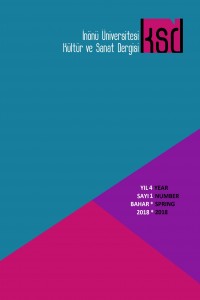Öz
20. yüzyılın başında Batı dünyasına sanat uygulamaları
odaklı bir öğreti sunan Gürciyef, müziklerinde birçok farklı kaynaktan
yararlanmıştır. Müzik yazma sürecinin dinleyici önünde gerçekleştiği ve pratik
alanda yapılan çalışmaların parçası olan müzikler özgün bir dile sahiptir.
Batı’ya sunulan üretimler olan müziklerde kullanılan çok çeşitli malzeme ve
sembolik içerik, kategorize edilmesi güç niteliklere sahiptir. Tüm inançlara mesafeli, evrensel bir
üst insan modelini hedefleyen metodun aynı zamanda ciddi bir modernizm
eleştirisi ile kurduğu sıradışı, zaman zaman tutarsız ve kışkırtıcı dilinin
derin sembolik araçları, çok sonra çözümlenmeye değer bulunmuştur. İnsanın bedensel,
zihinsel ve duygusal uyumunu hedefleyen metot bağlamında yapılacak okumalarla
içerik kendini görünür kılmaktadır. Müzik dışı eğilimlerin öne çıktığı beden deneyimi
odaklı uygulamalar, insan algısının farklı biçimlerini hedeflemesi bakımından
incelemeyi bekleyen bir alan olma özelliğini günümüzde de sürdürmektedir.
Müzikler ve metodun ilişkisini kavramaya yönelik bir bakış açısı geliştirmeyi
hedefleyen bu araştırmada, Gürciyef metodunda müziğin kullanımının nedenleri ve
müzik malzemesinin temel özellikleri araştırılırken Gürciyef’e ait metinler
temel kaynak olarak kullanılacaktır.
Anahtar Kelimeler
Gürciyef metodu Gürciyef sanat uygulamaları Gürciyef piyano müzikleri Thomas de Hartmann Müzik dışı yönelimler
Kaynakça
- 1. ALEXANDRE Christopher (1993), A Foreshadowing of 21st Century Art: The Color and Geometry of Very Early Turkish Carpets, Oxford University Press-NY. 2. Van DULLEMEN, Wim (2014), Gurdjieff’s Movements: The Pattern of All and Everything, Private Publication, Germany. 3. DE HARTMANN, Thomas (1992), Our Life with Gurdjieff, Arkana, New York. 4. GURDJIEFF, George I. (1991), Views From the Real World, Penguin Arkana, New York. 5. GURDJIEFF, George I. (1999), Beelzebub’s Tales to His Grandson: All and Everything, Arkana, New York 6. GURDJIEFF, George I. (2009), Olağanüstü İnsanlarla Karşılaşmalar, Çev. F. Seven-D. Yılmaz, RM Yayınları, İzmir. 7. NEEDLEMAN, J.-BAKER G.(1998), Gurdjieff: Essays and Reflections on the Man and His Teachings, Continuum Publishing, New York. 8. NOTT, Charles Stanley (1969), Further Teachings of Gurdjieff, Routledge and Kegan Paul, London. 9. PETSCHE, Johanna J.M.(2015), Gurdjieff and Music, Brill, Leiden. 10. Master’s of Wisdom, Sat 3 belgeseli, https://www.youtube.com/watch?v=t8GV0MX6Z00 ( Erişim tarihi: 23.03.2017)
- 11. Jean Cloude LUBTCHASKY, Documentary, 1976/INA
- 12. Miloslav DACIC ile özel ropörtaj, Aralık 2016
Öz
In the early 20th
century, using wide range of material in his music, Gurdjieff presents an art
focused teaching method to the West. Using music as a practical tool, with its
creation process which was infront of the audience, those music have a unique
approach. Meant to be received by western audience, the music has a very
strange quality to categorize with its symbolical content and mixed material. Targeting
a universal human model with its distance to all kind of believe sytems, the
method also has a sharp criticism about modernism with its off the chart,
provocative and dissonant
speech and its deep symbolic tools, which had not been recognized very soon. The content becomes
visible with
readings under the scope of the method aiming the harmony of mind, body and
emotion.
Extra musical tendency is a distinct quality of the applications which focuses
on experience and targetting human perception in different scales, is still
waiting to be invastigated. The aim of the research is to grasp a perspective
about the music in relation to the method. Further, Gurdjieff’s original text
which is the main material of the reseach; on why and whereabouts of usage of
music and its basics.
Anahtar Kelimeler
Gurdjıeff method Gurdjıeff art practices Gurdjıeff piano music Thomas de Hartmann Non-musical orientations
Kaynakça
- 1. ALEXANDRE Christopher (1993), A Foreshadowing of 21st Century Art: The Color and Geometry of Very Early Turkish Carpets, Oxford University Press-NY. 2. Van DULLEMEN, Wim (2014), Gurdjieff’s Movements: The Pattern of All and Everything, Private Publication, Germany. 3. DE HARTMANN, Thomas (1992), Our Life with Gurdjieff, Arkana, New York. 4. GURDJIEFF, George I. (1991), Views From the Real World, Penguin Arkana, New York. 5. GURDJIEFF, George I. (1999), Beelzebub’s Tales to His Grandson: All and Everything, Arkana, New York 6. GURDJIEFF, George I. (2009), Olağanüstü İnsanlarla Karşılaşmalar, Çev. F. Seven-D. Yılmaz, RM Yayınları, İzmir. 7. NEEDLEMAN, J.-BAKER G.(1998), Gurdjieff: Essays and Reflections on the Man and His Teachings, Continuum Publishing, New York. 8. NOTT, Charles Stanley (1969), Further Teachings of Gurdjieff, Routledge and Kegan Paul, London. 9. PETSCHE, Johanna J.M.(2015), Gurdjieff and Music, Brill, Leiden. 10. Master’s of Wisdom, Sat 3 belgeseli, https://www.youtube.com/watch?v=t8GV0MX6Z00 ( Erişim tarihi: 23.03.2017)
- 11. Jean Cloude LUBTCHASKY, Documentary, 1976/INA
- 12. Miloslav DACIC ile özel ropörtaj, Aralık 2016
Ayrıntılar
| Birincil Dil | Türkçe |
|---|---|
| Bölüm | Derleme |
| Yazarlar | |
| Yayımlanma Tarihi | 26 Mart 2018 |
| Yayımlandığı Sayı | Yıl 2018 Cilt: 4 Sayı: 1 |
https://dergipark.org.tr/tr/pub/ijca


